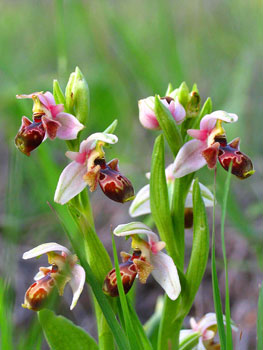
Asia Smitten With Neoliberalism? Or Struck Down With It?
March 22, 2014
Chasing Cherry Blossom in Japan
March 24, 2014Join pollinator extraordinaire, our very own Neil Geraghty as he embarks on a hunt for those elusive jewels of the plant world, orchids. No, not in Thailand but on a voyage of discovery through the relatively unknown beauty of Northern Cyprus. Let the magical mystery tour begin !
An orchid safari might seem like the easiest holiday in the world but I assure you, you need the suppleness of an Olympic gymnast to bend down and really appreciate these extraordinary masters of mimicry. I was crouching on my knees on a grassy hillside on North Cyprus’ bucolic Karpaz Peninsula, closely examining an exquisite bee orchid and the muscles in my back were within an inch of snapping in two. Mustafa, a local farmer with a silvery beard and moustache, was closely scrutinising me, in between taking long puffs from an acrid smelling cigarette. Sensing I was in pain, he bent over and to my horror nipped the stalk in two with his calloused fingers before handing me the orchid with a chivalrous smile. I vaguely remembered reading in a book that they took fifteen years to flower but nevertheless thanked him profusely for his generous present. Spotting a delicate pink flower spike nearby, he walked over and inflicted the same fate on that hapless bloom too. Calling me over, he invited me to take a closer look.

Salamis
“Bu adam”, he growled pointing at the petals on one of the tiny flowers. Adam means man in Turkish and sure enough I could see two eyes and a nose painted on the lip of the orchid.
“Bajaklar”, he bellowed, indicating two dangling petals that resembled legs. Then with a mischievous glint in his eye he pointed to a smaller leg in the middle and roared with laughter. This was Orchis Italica, the naked man orchid, one of the most common species on the island and one which always raises schoolboy titters amongst the orchid-loving population.
March is the peak month for orchid hunting, when you’ll often encounter hikers in the countryside peering into the undergrowth capturing images of orchids with long telescopic lenses. The island is home to 37 indigenous orchid species but a buttercup-yellow variety we spotted in the meadow had both Mustafa and my guide Onur stumped. It was a classic occasion when modern technology came to the rescue. Onur whipped out his iphone to browse the internet while Mustafa called an expert back in the village. A few minutes later they compared results and with looks of deep satisfaction on their faces, they announced the result to me – it was the Roman Orchid, Dactylorhiza Roman. Their enthusiasm was beginning to rub off on me. This delicate yellow flower might not have been a lion in the Ngorongoro Crater but nevertheless this sedate spring time safari had all the thrill of a big game hunt.

Orchid
Second only to orchids, tulips are paramount in Turkish Cypriots’ affections and vestiges of the vast fields that once supplied these treasured flowers to the Ottoman court still exist on the island. Mustafa was keen to show me one so we jumped into his mud splattered Land Rover and sped off along a dusty lane lined by ancient carob and olive trees. When we reached the tulip meadow I winced as Mustafa ploughed straight into it, flattening the blooms left, right and centre. Conservation awareness in this corner of the Mediterranean might be lacking but Mustafa glowed with pride as he showed me the deep vermillion flowers that were just beginning to open. Within a week, he told me, the field would be a blazing red, as far as the eye could see.

St Hilarion Castle
The short March tulip season is a small chapter in a wildflower extravaganza that begins in autumn when the first rains of the season awaken delicate mountain crocuses and ends in June when splashes of magenta oleander electrify the parched countryside. In March the landscape transforms into a shimmering gold mirage as drifts of yellow crown daisies meander through the corn fields. At the ancient ruined city of Salamis the colours can be seen to dazzling effect. Set in an enchanting location on a gentle hill that slopes down to the Mediterranean, the white marble ruins, sapphire blue waves and yellow carpets of daisies are as intense as a Van Gogh painting.

Giant fennel at Salamis
At Salamis I stumbled upon the surreal giant fennel which is known in Turkish as the ‘devil’s weed’ and for good reason. For two weeks in March this mammoth plant sends up a fleshy flower spike ten feet into the sky, while its huge feathery tendrils strangle everything in its wake. Walking amongst the smothered broken columns and headless statues, I had the strange sensation the city had been laid waste by an army of triffids.

Wild donkeys on the Karpaz Peninsula
Running along the northern spine of Cyprus, the serrated limestone crags of the Kyrenia mountains form a magnificent backdrop to North Cyprus’ popular seaside resorts. Peppering the summits of these contorted peaks is a line of Byzantine fortresses. St Hilarion is one of the most beautiful and is perched high upon an inaccessible crag. This redoubtable castle once kept a hawk’s eye surveillance on corsair pirates who terrorised the Cypriot coast. Steeped in romantic legends, Richard the Lionheart captured the castle during the Third Crusade and rumour has it that Walt Disney modelled Snow White’s castle on St Hilarion, whose fortifications follow an uncannily similar pattern. Walking through the courtyard, the castle certainly exuded a fairy tale like quality. Amongst the cracked flagstones, clumps of mandrakes were in full flower, their mysterious deep purple bells redolent of many a wicked stepmother’s spell.
 Orchid – Ophrys umbilicata |
 Naked Man Orchid |
The walk up to the castle had been a steep one so I was delighted when Mustafa Gursel, proprietor of the castle café, offered me a glass of refreshing homemade lemonade. In the cafe he had arranged a collection of framed orchid photos whose intricate pink and yellow blooms stood out beautifully against the rough grey stone of the castle walls. When I asked him about these photos he modestly told me that he had taken them himself and would I like to see some more in his collection? Loading a CD into his computer I was soon blown away by the hundreds of exquisite photographs he had spent years compiling. Back outside, he pointed out a delicate white flowered plant, clinging onto the castle walls. It was the mundanely named St Hilarion cabbage, one of several species of plant unique to the microclimate of these beautiful mountains.
 Naked Man Orchid |
 Bee Orchid |
Well sign-posted mountain trails weave across the Kyrenia mountains and follow the paths of ancient goat tracks and pilgrim routes that once linked secluded monasteries lying hidden in the forests. The best walks can be found on the slopes of Besparmak Mountain which rises like a clenched fist over the picturesque port of Kyrenia. On my last day in North Cyprus I headed up the slopes for a hike along one of these trails. Underneath the dappled forest canopy, clumps of pink orchids were poking through carpets of fallen pine needles. Occasionally the trees thinned out to reveal banks of lilac anemones nodding in the breeze. In one of these clearings I sat down to enjoy the view. In the crystal clear air I could clearly see the distant snow-capped Taurus mountains rising majestically out of the Mediterranean along the Turkish coast. The view was absolutely breathtaking and lying down amongst the flowers with the sunshine warming my face, I could not think of a more beautiful spot to enjoy a glorious Mediterranean spring.
[note]
Fact Box
North Cyprus specialist The Discovery Collection (tel: 01371 859733, thediscoverycollection.com) .
For more information on North Cyprus visit www.welcometonorthcyprus.co.uk
[/note]




